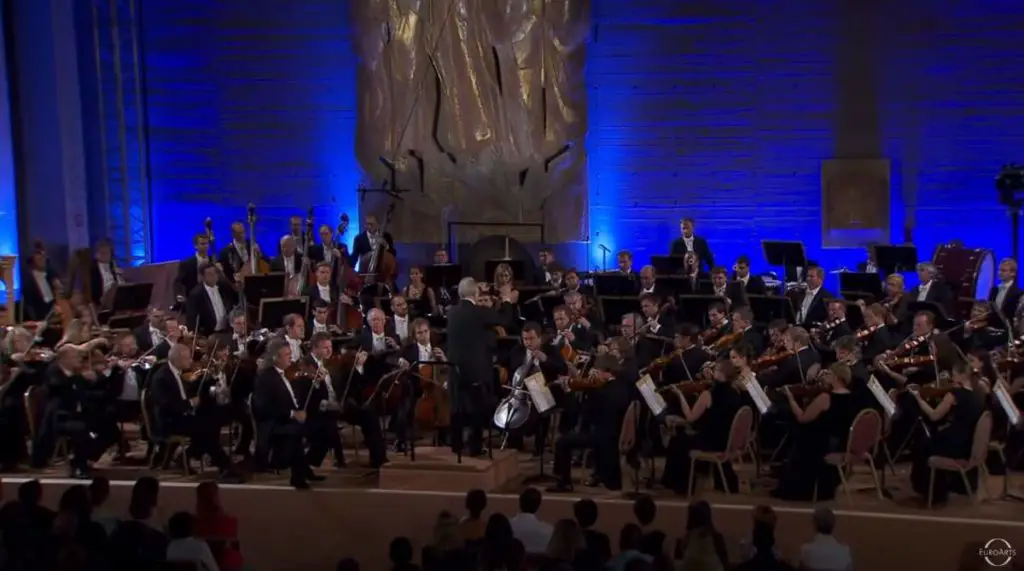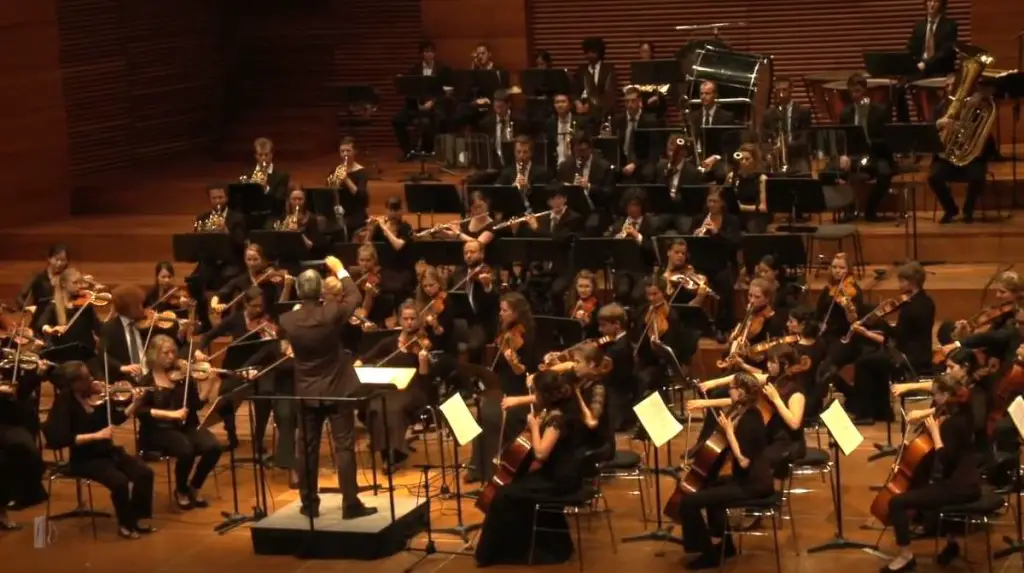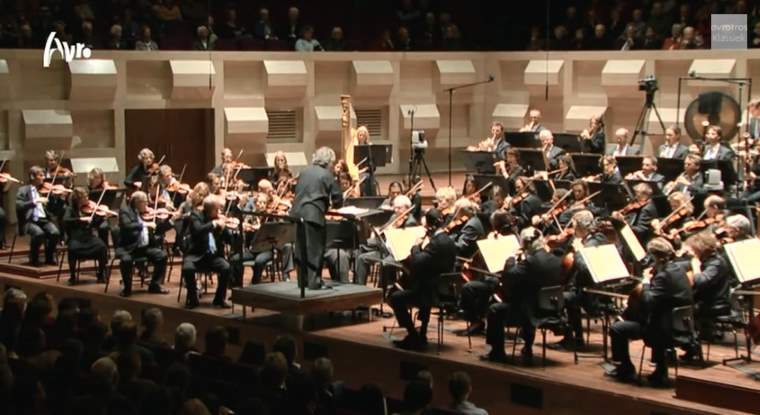Conducted by Yuri Temirkanov, the Saint Petersburg Philharmonic Orchestra performs Nikolai Rimsky-Korsakov’s Scheherazade, Op. 35, a symphonic suite composed in 1888. Recorded during the 2013 Annecy Classic Festival.
In its fourth edition, the Annecy Festival has become a major player in the national and international cultural landscape. In residence at the 2013 Annecy Classic Festival, the Saint Petersburg Philharmonic Orchestra, Russia’s oldest symphony orchestra joins forces with its iconic conductor Yuri Temirkanov.
Temirkanov conducts the orchestra in a performance of Rimsky-Korsakov’s lush Sheherazade, with its intoxicating scents and the glowing, oriental colors – a journey through One Thousand and One Nights.
Nikolai Rimsky-Korsakov’s Scheherazade
Nikolai Rimsky-Korsakov’s “Scheherazade,” Op. 35, is a symphonic suite composed in 1888, and it stands as one of the most celebrated and enduring works in the orchestral repertoire. Inspired by “One Thousand and One Nights,” also known as “The Arabian Nights,” the composition is imbued with exoticism, vivid orchestration, and a narrative depth that showcases Rimsky-Korsakov’s mastery of musical storytelling. Unlike a traditional symphony with its structured movements, “Scheherazade” is a suite that weaves together four thematically connected movements, each portraying different tales as recounted by the eponymous Scheherazade, a sultan’s wife who tells stories to postpone her execution.
Rimsky-Korsakov was a member of “The Mighty Handful,” a group of Russian nationalist composers, and his work reflects a fascination with orientalism and folk tales, which were popular themes among Russian composers during this period. “Scheherazade” is notable for its use of the orchestra to paint vivid pictures and tell stories without words. The composer employs a rich palette of instrumental colors and thematic material to evoke the settings and characters of the Arabian Nights tales, making extensive use of leitmotifs-musical themes associated with particular characters or ideas.
The suite opens with a powerful theme representing the Sultan, which is contrasted with the gentle, lyrical violin solo that introduces Scheherazade herself, serving as a recurring motif throughout the piece. This contrast sets up the narrative framework, with the Sultan’s imposing presence and Scheherazade’s captivating storytelling prowess.
Rimsky-Korsakov’s orchestration is both innovative and lavish, utilizing the full range of the orchestra to achieve effects that suggest the exotic landscapes, dramatic events, and emotional depths of the stories being told. The music moves through moods of excitement, love, danger, and mystery, with the composer’s skillful orchestration bringing to life the sea voyages, battles, and romantic tales that Scheherazade narrates.
“Scheherazade” is not only a technical showcase for the orchestra but also a work of great emotional impact, demonstrating Rimsky-Korsakov’s ability to create music that is both vividly descriptive and deeply expressive. The suite has enjoyed enduring popularity since its premiere, captivating audiences with its lush melodies, dazzling orchestration, and evocative storytelling. It remains a testament to Rimsky-Korsakov’s imagination and technical prowess, as well as his contribution to symphonic literature and the portrayal of narrative in music.
Movements
With the starting times in the video):
- 00:55 The Sea and Sinbad’s Ship
- 10:45 The Story of the Kalender Prince
- 23:40 The Young Prince and the Young Princess
- 33:52 Festival at Baghdad. The sea. The Ship breaks against a cliff surmounted by a bronze horseman
1. The Sea and Sinbad’s Ship
The first movement of Nikolai Rimsky-Korsakov’s “Scheherazade,” Op. 35, titled “The Sea and Sinbad’s Ship,” serves as a vivid musical painting, evoking images of the sea and the adventures of Sinbad the Sailor. This movement, like the rest of the suite, is not intended to follow the narrative of “The Arabian Nights” literally but rather to evoke the atmosphere and emotions associated with the tales.
The movement begins with a strong, commanding theme introduced by the lower strings and brass, representing the stern and authoritative voice of the Sultan. This is contrasted with the solo violin’s lyrical and delicate theme, which symbolizes Scheherazade herself, the sultan’s wife, who tells these stories to delay her execution. The solo violin’s theme is one of the most recognizable melodies in classical music, noted for its beauty and expressive quality. The interplay between the imposing Sultan theme and the enchanting Scheherazade theme sets the stage for the storytelling that follows.
As the movement unfolds, Rimsky-Korsakov employs a variety of orchestral textures and colors to depict the sea and Sinbad’s adventures. The music alternates between calm passages that suggest the gentle motion of the sea and more turbulent sections that capture the drama of Sinbad’s encounters with mythical creatures and perilous storms. The composer’s mastery of orchestration is on full display, with the use of woodwinds, brass, strings, and percussion to create a rich, immersive sound world.
The use of thematic development and variation is central to the movement’s structure, with the initial themes undergoing transformations that reflect the evolving narrative. Rimsky-Korsakov’s skillful use of orchestral color and his ability to evoke vivid imagery through music makes “The Sea and Sinbad’s Ship” not just an opening movement but a standalone piece that captures the listener’s imagination and transports them to a world of fantasy and adventure.
2. The Story of the Kalender Prince
The second movement of Nikolai Rimsky-Korsakov’s “Scheherazade,” Op. 35, is titled “The Story of the Kalendar Prince.” This movement continues the suite’s exploration of the tales from “One Thousand and One Nights,” with music that is vividly descriptive and evocative of the narrative qualities of the stories being told. Rimsky-Korsakov, a master of orchestration and thematic development, uses the orchestra to paint aural pictures that bring the story of the Kalendar Prince to life.
This movement is marked by its varied and expressive themes, which represent different aspects of the story and the characters within it. The solo violin, representing Scheherazade herself, introduces the movement and weaves through it, providing a narrative thread that connects the listener to the overarching frame of the tale. The violin’s themes are lyrical and intricate, showcasing the soloist’s virtuosity and the emotional depth of the music.
The Kalendar Prince’s story is characterized by a series of dramatic and contrasting musical ideas, reflecting the adventures and misfortunes he encounters. Rimsky-Korsakov employs a wide range of orchestral colors and textures to depict these scenes, from the mysterious and exotic to the bold and heroic. The use of woodwinds, brass, and percussion, in particular, adds layers of color and intensity to the music, creating a vivid portrayal of the prince’s journey.
One of the hallmarks of this movement is its use of thematic transformation, where musical themes are varied and developed to represent the unfolding story. This technique allows Rimsky-Korsakov to maintain a sense of cohesion throughout the movement while also exploring a wide range of moods and settings. The dynamic interplay between the solo violin and the orchestra, along with the richly textured orchestration, makes “The Story of the Kalendar Prince” a compelling and immersive listening experience.
3. The Young Prince and the Young Princess
The third movement of Nikolai Rimsky-Korsakov’s “Scheherazade,” Op. 35, is titled “The Young Prince and The Young Princess.” This movement is often celebrated for its exquisite beauty, tender melodies, and the romantic atmosphere it evokes, serving as a lyrical interlude within the larger suite. Rimsky-Korsakov’s orchestration shines here, with a focus on the melodic lines that convey the love story between the young prince and princess, capturing the essence of their youthful romance and mutual affection.
Musically, the movement is characterized by its sweeping, melodious themes that flow with an almost effortless grace. The opening section introduces a gentle, singing melody that is taken up by various sections of the orchestra, with a particular emphasis on the woodwinds and strings. The solo violin-Scheherazade’s voice throughout the suite-again plays a significant role, offering delicate, expressive passages that enhance the narrative quality of the music.
The orchestration is rich yet refined, with Rimsky-Korsakov employing a palette of orchestral colors to paint the emotional landscape of the young lovers’ tale. The use of harp and the lyrical passages for the woodwind instruments contribute to the movement’s ethereal, dreamlike quality. The interplay between the orchestra’s sections creates a texture that is both intricate and transparent, allowing the movement’s thematic material to shine through clearly.
“The Young Prince and The Young Princess” is structured in a way that mirrors the unfolding of a love story, with musical phrases that ebb and flow like the emotions of the protagonists. The movement progresses through various moods and intensities, from the initial tender and idyllic themes to more passionate and expressive moments, before returning to the tranquility and sweetness of the opening melody. This cyclical structure enhances the narrative effect of the music, drawing listeners deeper into the story being told.
4. Festival at Baghdad. The sea. The Ship breaks against a cliff surmounted by a bronze horseman
The fourth and final movement of Nikolai Rimsky-Korsakov’s “Scheherazade,” Op. 35, is titled “Festival at Baghdad. The Sea. The Ship Breaks against a Cliff Surmounted by a Bronze Horseman.” This movement is a vivid and dynamic conclusion to the suite, encapsulating the dramatic and colorful storytelling that characterizes the entire work. It combines elements of adventure, drama, and the exotic to bring the narrative of Scheherazade and her tales to a climactic finish.
Rimsky-Korsakov’s orchestration in this movement is particularly notable for its energy and the use of a wide range of instrumental colors to depict the scenes and events of the story. The movement begins with a lively and spirited theme that suggests the bustling activity and festive atmosphere of Baghdad. The music conveys the vibrancy of the city with fast-paced rhythms and brilliant orchestral textures.
As the movement progresses, the music shifts to depict the majesty and mystery of the sea, with flowing melodies and harmonies that evoke the undulating movements of the waves. Rimsky-Korsakov’s skill in creating musical pictures is evident here, as he uses the orchestra to suggest the vastness and beauty of the maritime landscape.
The narrative then leads to the dramatic climax of the suite, where the ship encounters a massive storm and is ultimately shattered against a cliff surmounted by a bronze horseman, a statue that stands as a silent witness to the ship’s demise. The music captures the drama and intensity of this moment through powerful orchestral forces, including crashing cymbals and stormy passages that mimic the chaos of the shipwreck.
Throughout the movement, the solo violin-representing the voice of Scheherazade-returns with its themes, reminding the listener of the framing device of the tales being told to the Sultan. These interludes provide moments of lyrical beauty and reflection amidst the movement’s overall dynamism.
The movement, and thus the suite, concludes with a return to the theme associated with Scheherazade, bringing the work full circle. The ending is both triumphant and poignant, leaving a lasting impression of the power of storytelling and the imagination.
The fourth movement of “Scheherazade” is a masterful example of Rimsky-Korsakov’s compositional prowess and his ability to fuse narrative and music. It serves as a fitting conclusion to the suite, showcasing the composer’s talent for creating vivid orchestral tableaux and his deep understanding of the tales that inspired the music.
Saint Petersburg Philharmonic Orchestra

The Saint Petersburg Philharmonic Orchestra was formed in 1882. It was initially known as the “Imperial Music Choir” and performed privately for the court of Alexander III of Russia. By the 1900s it had started to give public performances at the Philharmonia and elsewhere. Richard Strauss conducted the orchestra in 1912.
After the Russian Revolution, the orchestra was taken over by its members, who changed the name to the “State Philharmonic Orchestra of Petrograd”. In the 1920s the orchestra began receiving support from the state and began to be known internationally as an excellent orchestra. At this time, Bruno Walter, Ernest Ansermet, and Hans Knappertsbusch made guest conductor appearances. The city of Petrograd was renamed Leningrad three days after the death of Vladimir Lenin, the founder of the Soviet Union. Around this time the orchestra was renamed the Leningrad Philharmonic Orchestra.
The orchestra gained its most fame under the lengthy directorship of Yevgeny Mravinsky. The orchestra made a few tours to the West, but it recorded some studio and live recordings under Mravinsky. Furthermore, it was under Mravinsky that the orchestra premiered seven of Shostakovich’s symphonies.
In 1991 the orchestra gained its current name after its home city returned to its original name of Saint Petersburg. Today it is an internationally recognized symphony orchestra under the directorship of Yuri Temirkanov.
Yuri Temirkanov

Yuri Khatuevich Temirkanov (born December 10, 1938, in the Caucasus city of Nalchik) is a Russian conductor of Circassian (Kabardian) origin.
Yuri Temirkanov has been the Music Director and Chief Conductor of the Saint Petersburg Philharmonic since 1988.
After winning the prestigious All-Soviet National Conducting Competition in 1966, Temirkanov was invited by Kirill Kondrashin to tour Europe and the United States with legendary violinist David Oistrakh and the Moscow Philharmonic Orchestra. Yuri Temirkanov made his debut with the Leningrad Philharmonic Orchestra in early 1967 and was then invited to join the Orchestra as Assistant Conductor to Yevgeny Mravinsky. In 1968, he was appointed Principal Conductor of the Leningrad Symphony Orchestra where he remained until he was appointed Music Director of the Kirov Opera and Ballet in 1976.
Maestro Temirkanov is a frequent guest conductor of the leading orchestras of Europe, Asia, and the United States. He holds the distinction of being the first Soviet artist permitted to perform in the United States after cultural relations were resumed with the Soviet Union at the end of the war in Afghanistan in 1988.
In addition to leading the Saint Petersburg Philharmonic, Maestro Temirkanov served as the Baltimore Symphony Orchestra’s 11th Music Director from 2000 until 2006 and is currently the Principal Guest Conductor of the Danish National Symphony Orchestra and Conductor Laureate of the Royal Philharmonic Orchestra in London. In 2015 he was assigned by Teatro La Fenice the prize “A life for music”, unofficially known as the “Nobel Prize for Musicians”.
Sources
- Saint Petersburg Philharmonic Orchestra on Wikipedia
- Yuri Temirkanov on Wikipedia
- Scheherazade (Rimsky-Korsakov) on Wikipedia
- Scheherazade, Op.35 (Rimsky-Korsakov, Nikolay) on the International Music Score Library Project website



